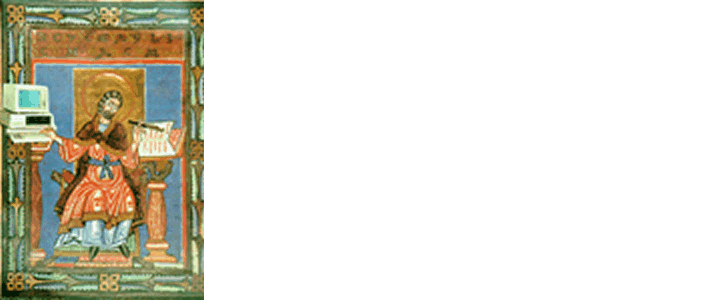 |
|
| |
|
Exegesis
|
| |
| |
|
Structuralist Criticism
| |

|
Definition
|
- Structuralist
criticism begins with the insight of Ferdinand de Saussure
that words are assigned to the things they describe not
out of necessity but rather out of convention, and that
these conventions—how things mean rather than
what they mean—are therefore the proper focus
of study. Words as signs signify not by the inherent
nature of the word but rather by a complex web of relationships
with and differences from other words in the linguistic
system. To this linguistic focus, Claude Lévi-Strauss
added the anthropologist's insight that the rules governing
the relationships of words also work within the social system
to shape human relationships and other cultural phenomena. Structural
criticism quickly diversified into a variety of different
approaches, but all of them share the concern to identify
the cultural codes that lie behind texts.

| |

|
Method
|
- In
his introductory book Structural Exegesis for New Testament
Criticism, Daniel Patte collates the processes of various
structural theorists into the following six steps:
-
-
- Identify the discourse unit. The first
step is to identify a discrete unit of narrative
(seams occur at breaks in setting, character, time
and/or theme) or rhetoric (e.g., a change of theme/topic
in an argument).
- Determine the explicit oppositions of actions.
The author of a biblical text will reveal their
convictions whenever they say not only what they
mean to say, but what they do not
mean to say. Often the characters in the story perform
the author's convictions—both what the author
means to say and what s/he does not mean to say—and
so if you can identify these oppositions you can
identify the author's convictions.
- Identify the qualifications through which
the opposed characters are contrasted.
- Identify the effects of their actions on
the receivers/their opponents.
- Draw conclusions about the author's convictions
based on the opposed actions and the reactions of
the characters.
- Name the features of the discourse unit:
how the author uses the opposed actions, metaphor
and figurative speech to convey his/her convictions
to the audience. One should also consider at this
stage the way the author has used prior sources
and what relationship the author has to his/her
audience.

| |

|
Example
|
- This
will be added soon.

| |

|
Bibliography
|
- Method
- Patte,
Daniel. The Religious Dimensions of Biblical Texts: Greimas's Structural Semiotics and Biblical Exegesis, Semeia Studies. Atlanta, Scholars Press, 1990.
-
- --------. Structural Exegesis for New Testament Critics, Guides to Biblical Scholarship, New Testament Series. Minneapolis: Fortress, 1990.
-
- Patte, Daniel and Aline Patte. Structural
Exegesis: From Theory to Practice Philadelphia:
Fortress, 1978.
-
- Polzin, Robert M. Biblical Structuralism:
Method and Subjectivity in the Study of Ancient Texts,
Semeia Supplements. Philadelphia: Fortress,
1977.
-
- Applications
- Boers, Hendrikus. Neither on This Mountain
Nor in Jerusalem: A Study of John 4, SBLMS 35. Atlanta:
Scholars Press, 1988.
-
- Calloud, Jean. Structural Analysis of Narrative: Temptation of Jesus in the Wilderness, trans. D. Patte, Semeia Supplements. Philadelphia: Fortress, 1976.
-
- Crossan, John Dominic. "It is Written:
A Structuralist Analysis of John 6." Semeia
26 (1983) 3-21. Reprinted in The Dark Interval: Towards
a Theology of Story. Sonoma, California:
Polebridge, 1988.
-
- Jobling, David. The Sense of Biblical
Narrative: Three Structural Analyses in the Old Testament. Sheffield:
JSOT, 1978.
-
- --------. The Sense of Biblical Narrative
II: Structural Analyses in the Hebrew Bible. Sheffield:
JSOT, 1986.
-
- Johnson, Alfred M., ed. The New Testament
and Structuralism: A Collection of Essays, Pittsburgh
Theological Monographs 11. Pittsburgh: Pickwick,
1976.
-
- Leach, Edmund. Genesis as Myth and Other
Essays. London, Cape, 1969.
-
- Malbon, Elizabeth Struthers. Narrative
Space and Mythic Meaning in Mark. San
Francisco: Harper & Row, 1986.
-
- --------. "'No Need
to Have Any One Write'? A Structural Exegesis of 1 Thessalonians." Semeia
26 (1983) 57-83.
-
- Patte, Daniel. The Gospel According to Matthew: A Structural Commentary on Matthew's Faith. Philadelphia: Fortress, 1987.
-
- --------. Paul's Faith and the Power
of the Gospel: A Structural Introduction to the Pauline
Letters. Philadelphia: Fortress, 1983.
-
- Polzin, Robert. Moses and the Deuteronomist:
A Literary Study of the Deuteronomic History. New
York: Seabury, 1980.
-
- Via, Dan. Kerygma and Comedy in the
New Testament: A Structuralist Approach to Hermeneutic. Philadelphia:
Fortress, 1985.
|
|
| |
|
|
|